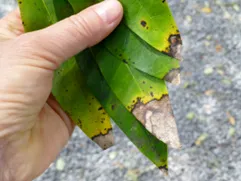By Kim Wilson, UC Master Gardener

Sudden Oak Death (SOD) is an exotic disease caused by a fungus-like organism, Phytophthora ramorum. Many Phytophthora species are soil dwelling, root pathogens but the causative agent of SOD is not a root pathogen. Phytophthora ramorum has not been detected in samples of California bay laurel trees as of 2024. SLO County is considered not infested with this pathogen.
SOD pathogen diseases:
- Fatal canker disease known as Sudden Oak Death- infects and kills several oak species- Black oak, coast live oak, canyon live oak and Shreve’s oak. It can also infect and kill tanoak. This infection is in the wood of the branches and trunk. The pathogen enters through cracks in the bark and is not a root pathogen.
- Non-fatal foliar disease known as Ramorum blight- infects more than a hundred landscape and native plants. The infection targets the leaves and it can cause leaf symptoms or twig dieback, but most often doesn’t cause death of the plant. These infected plants are a breeding ground for the pathogen and the primary source of SOD infection in oaks.
Disease Transmission
- The pathogen requires water to become infectious; it does not produce spores until it rains. Once the spores are produced, they are carried by wind to nearby susceptible plants and trees.
- The disease is more active during rainy years and slows during dry periods. The disease can spread 100 yards/year or up to a several miles in a rainy year.
- The numerous foliar hosts are the vectors of disease and are highly infectious. California bay laurel is the most important vector
- The oak trees are not vectors and the disease does not travel between oak trees.
- Tanoak, which is not a true oak, has the distinction of being able to get the foliar disease and thus transfer the disease, but can also acquire the canker disease resulting in death.
- Wind and rain are the primary modes of transmission. Movement of people, animals, and soil are a minor contributor to pathogen spread. Cleaning or brushing off dirt from shoes, bike tires, and pruning equipment significantly reduces the transfer of the pathogen.
Identification of the Disease
- Identify if susceptible plants are present at your location and know the signs of infection.
- Determine the risk at your location: SODmap mobile app is a free app for your mobile device. This app can show the actual risk of infection at your location using data from trees tested during the SOD Blitz (see below). It will rate your risk as high/moderate, low or insufficient data.
Prevention and Treatment
The key to prevention is to identify and understand the distribution of host plants and trees in your area. The California bay laurel is the most important vector.
- There is no effective treatment for infected oaks.
- If infected host plants are present or if the SODmap mobile app shows high to moderate risk then identify high value oaks and consider selective removal of nearby bay laurel trees to provide a buffer zone of 30-65 feet. This decision is based on the value and size of the oaks vs. the bay laurel trees. The larger the oak trees, the larger the buffer zone. For areas of low to insufficient data then plan to monitor for signs of disease on host plants and trees.
- In high-risk areas or locations with known SOD infected host plants, healthy oaks can be protected with a single yearly treatment of phosphonate between November 1st and December 15th. This is a preventive measure and is not effective in treating infected oaks.
How You Can Help
UC Berkeley along with the CA Native Plant Society (CNPS) train citizen volunteers each spring to collect symptomatic California bay laurel leaves and document the trees’ locations. These results are announced in mid-October and serve as the data for the SODmap mobile app. Watch our website UC Master Gardeners San Luis Obispo for SOD Blitz registration in the spring. If you are interested in monitoring the risk of infection in your area, the free SODmap mobile app can be downloaded.
References
Summary of the Results of the 2024 Sudden Oak Deat (SOD) Blitzes. PDF. UC Berkeley.
Highlights-2024-SOD-Blitzes.pdf
"Sudden Oak Death". UC BERKELEY FOREST PATHOLOGY AND MYCOLOGY LAB. Sudden Oak Death – SOD Blitz Survey & COVID-19 – UC BERKELEY FOREST PATHOLOGY AND MYCOLOGY LAB
"Sudden Oak Death". UC IPM. Sudden Oak Death / Home and Landscape / UC Statewide IPM Program (UC IPM)
Sudden Oak Death Symptoms on California Bay Laurel. PDF. Slide 1
"What Is Sudden Oak Death?” California Oak Mortality Task Force. Home - Sudden Oak Death
